Saturdays, noon to 1 p.m. ET on WICR 88.7 FM.
Or listen live from anywhere on WICR Online!
Our call-in number during the show: (317) 788-3314

September 1, 2018
County homes, once known as "poor asylums"

In 1816, the first Indiana Constitution required counties "to provide one or more farms to be an asylum for those persons who by reason of age, infirmity or other misfortunes may have a claim upon the beneficence of society."
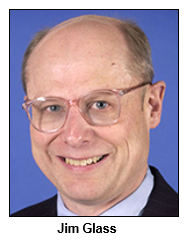
Most of the county homes closed after the creation of Social Security during the 1930s. But ten continue to operate across Indiana to this day.
Among them is the Hendricks County Home, known as Cypress Manor, a 31-bed residential care facility in Danville. Its administrator, James McBryant, will join Jim Glass, principal of Historic Preservation & Heritage Consulting, as Nelson's studio guests to explore the heritage of county homes. Jim Glass has been researching various aspects of the homes, including their widely varying architectural styles, for Indiana Landmarks, the historic preservation advocacy organization.

"The farms ranged in size from less than 50 acres up to 350 acres and, in the early 20th century, many thrived," Jim says. Excess vegetables and fruit sometimes were sold to defray operating costs, he adds.
The Hendricks County Home and others that continue to operate do so under the belief that poverty relief is best handled by local government, our guest James McBryant says. Current residency in Cypress Manor, he adds, is restricted to people who are indigent and do not qualify for services in other facilities.
In addition to Hendricks County, counties in Indiana with homes that continue to operate include Carroll and Clinton counties. Elsewhere, including in Knox and Randolph counties, the residences have been closed, but the structures of the former homes still stand. Indiana Landmarks initiated the current research effort with the intent of getting several of these properties listed on the National Register of Historic Places.
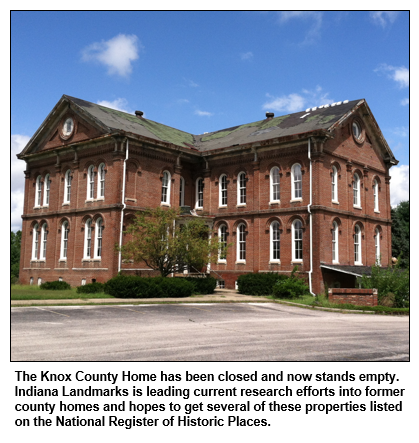
"By the late 19th century, most homes included a front portion designed as a comfortable residence for the superintendent and his family," Jim adds. "The residents of the asylum/county home lived in wings to the rear . . . with men and women living in separate wings or corridors."
After World War II, the farmland adjacent to most county homes was sold. According to Jim, the focus "shifted to care for mostly elderly residents and less on providing a venue for work."
In Hendricks County, construction began in 1868 of Cypress Manor, which replaced earlier structures used as the county home. The farm adjacent to Cypress Manor once was hundreds of acres in size; today, the 3-acre property includes the lawn, flower gardens and a small vegetable garden, according to James McBryant.
All residents of Cypress Manor must be capable of feeding and bathing themselves, he adds. "Residents also are responsible for maintaining their sleeping rooms and doing their laundry."
Our guest James McBryant has been the administrator of Cypress Manor for 15 years. During his tenure, he has been an advocate for preserving county homes as a service to local communities.
Jim Glass, the former director of Indiana Department of Natural Resources' division of historic preservation, has been a guest on several Hoosier History Live shows. They have included a program in 2014 about the Natural Gas Boom of the 1880s and '90s.
History Mystery

It wasn't a county home. Nor was the Marion County Children's Guardian Home an orphanage, contrary to public perceptions. Instead, the Guardian Home - housed in a massive structure built in 1918 in a historic neighborhood in Indianapolis - was a shelter for children who were neglected, abused or abandoned. In 2009, after more than 100 years of housing children ranging from preschoolers to teenagers, the Marion County Children's Guardian Home located in the historic neighborhood closed.
But the massive structure still stands. Today, it houses a charter school primarily attended by students who live in the historic neighborhood that surrounds the building.
Question: What is the historic neighborhood?
The call-in number is (317) 788-3314. Please do not call in to the show until you hear Nelson pose the question on the air, and please do not try to win if you have won any other prize on WICR during the last two months. You must be willing to give your first name to our engineer, you must answer the question correctly on the air and you must be willing to give your mailing address to our engineer so we can mail the prize pack to you. The prizes are is a gift certificate to Story Inn in Brown County, courtesy of Story Inn, and two admissions to the Indiana History Center, courtesy of the Indiana Historical Society.
Roadtrip: Old Medora Brick Plant in Jackson County
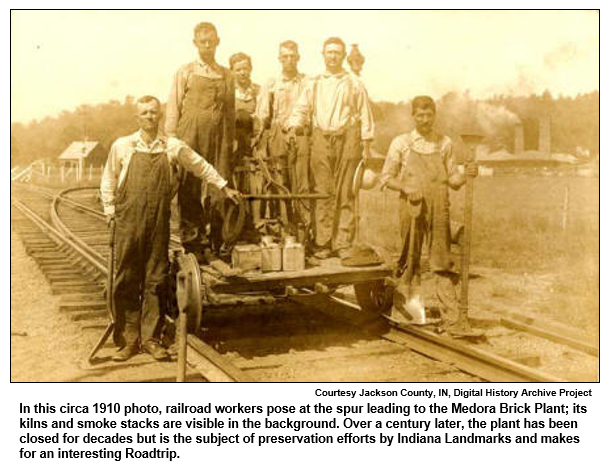
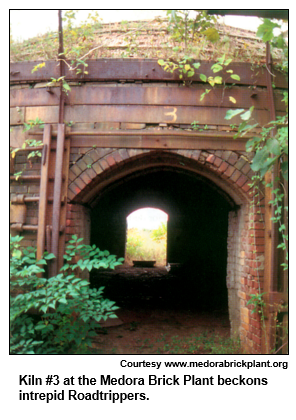
The Medora Shale Brick Company was founded in 1904. The nearby Baltimore and Ohio Railroad carried the finished Medora brick throughout the Midwest. At its peak, the Medora Shale Brick Company employed a 50 person workforce and produced 54,000 handmade bricks a day from its twelve domed kilns.
You can see Medora brick on the campuses of Ball State University, the University of Louisville, and the University of Kentucky.
In 2004, Indiana Landmarks put the plant on its Ten Most Endangered Landmarks list, and today the plant is owned by Medora Brick Plant and Historical Sites, Inc.
And if you're a fan of covered bridges, Ken also tells us that Medora Covered Bridge is nearby and has been fully restored! Learn more on Saturday!
Post our podcasts, please!
As readers have surely noticed, we are posting links to weekly podcasts of Hoosier History Live at the top of our newsletter and website, generally on the Friday following the live Saturday show. Feel free to copy and paste the links to our podcasts anywhere you connect with others on the Internet. Tweet it to your followers and post it to your FaceBook friends - we love social media! We do request that you not edit or alter the audio files because they contain underwriter credits, and we need their support!
When you do post a podcast link, we appreciate it if you put "Courtesy of Hoosier History Live" and a link to our website www.hoosierhistorylive.org next to the post. As with all media, the more people know about us, the better.
Nelson Price, host and historian
Molly Head, producer/project manager, (317) 927-9101
Michael Armbruster, associate producer
Cheryl Lamb, administrative manager
Richard Sullivan, senior tech consultant
Pam Fraizer, graphic designer
Garry Chilluffo, special events consultant

Please tell our sponsors that you appreciate their support!

 Acknowledgments to Monomedia, Visit Indy, WICR-FM, Fraizer Designs, Heritage Photo & Research Services, Henri Pensis, Chris Shoulders, Aaron Duvall, and many other individuals and organizations. We are an independently produced program and are self-supporting through organizational sponsorship, and by individual contribution at the yellow button on our newsletter or website. For organizational sponsorship, which includes logos, links, and credits in the show, contact Molly Head at (317) 927-9101 or email her at molly@hoosierhistorylive.org. And any of our podcasts can be sponsored for a nominal fee.
Acknowledgments to Monomedia, Visit Indy, WICR-FM, Fraizer Designs, Heritage Photo & Research Services, Henri Pensis, Chris Shoulders, Aaron Duvall, and many other individuals and organizations. We are an independently produced program and are self-supporting through organizational sponsorship, and by individual contribution at the yellow button on our newsletter or website. For organizational sponsorship, which includes logos, links, and credits in the show, contact Molly Head at (317) 927-9101 or email her at molly@hoosierhistorylive.org. And any of our podcasts can be sponsored for a nominal fee.
Thank you!
We'd like to thank the following recent, new and renewal contributors whose donations help make this show possible!
- Dave and Theresa Berghoff
- Ann S. Frick
- Adam Rickert
- Carol Bacon
September 8, 2018 - Upcoming
Early French influence in the territory that became Indiana

Indiana's French heritage isn't always as obvious as that of ethnic groups such as the Germans and Irish, who arrived in the Midwest in far larger numbers during the peak years of European immigration into Indiana in the the mid 1800s.
Few if any areas of Indiana have a concentrated population that can boast of French ancestry, and French cultural centers akin to the Germanic Atheneum are conspicuously absent here. Alas, aside from the annual French Market festival in Indianapolis, it can even be hard to find authentic French cuisine in the Hoosier capital.
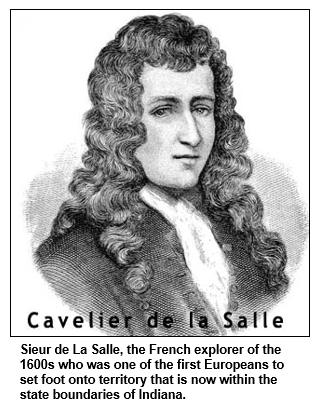
In fact, the French were the first Europeans to explore and settle in what would become Indiana, and their complex relationship with the Native American tribes - as well as their later rivalry with the British - set the course for historic developments that resound unto this day.
To take a look into the legacy of French explorers, fur traders, and missionaries in Indiana, Hoosier History Live associate producer and guest host Mick Armbruster will delve into questions about the early French presence in Indiana. What brought the French to the region before any other Europeans? How did they interact with the Native American tribes who were already living here? How did the French mediate conflicts between those tribes, and later come into conflict themselves with westward-expanding British colonists?
And what is the legacy of the early French explorers, fur traders and missionaries today, given that so few of their descendents remain in the state?

And even if you remember covering this territory in your fourth grade Indiana History class, Richard may have some surprises for you. For example, he'll talk about the Code Noir that governed the French treatment of enslaved Africans in the New World. He'll also expound upon the role played by the Jesuit missionaries in the French colonial settlements.
In addition, Mick and Richard will be joined via call-in by Bob Dora, former board member of the Society of Indiana Pioneers and a specialist in the history of early French influences in Indiana. Bob's interest in the subject comes naturally: he can trace his Indana ancestry back to a member of the party of Sieur de La Salle, the French explorer of the 1600s who was one of the first Europeans to set foot onto territory that is now within the state boundaries of Indiana.
Bob grew up knowing almost nothing about his family history until he started looking into his genealogy as an adult. Among his surprising discoveries: he had ancestors who had participated in the American Revolution and had been granted land for their service in the fight for Independence.
Researching his family history has been "like an onion," Bob says. "You peel back a layer and find something extraordinary in the next layer."
© 2018 Hoosier History Live. All rights reserved.
|






